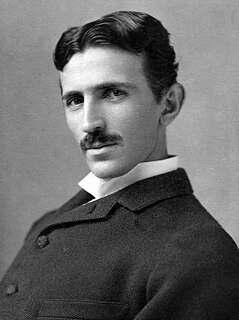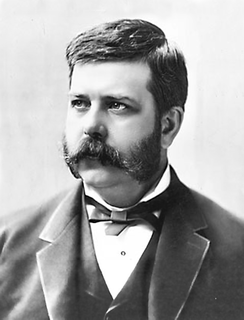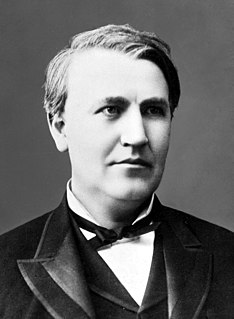Related Research Articles

Nikola Tesla was a Serbian-American inventor, electrical engineer, mechanical engineer, and futurist best known for his contributions to the design of the modern alternating current (AC) electricity supply system.

George Westinghouse Jr. was an American entrepreneur and engineer based in Pennsylvania who created the railway air brake and was a pioneer of the electrical industry, receiving his first patent at the age of 19. Westinghouse saw the potential of using alternating current for electric power distribution in the early 1880s and put all his resources into developing and marketing it. This put Westinghouse's business in direct competition with Thomas Edison, who marketed direct current for electric power distribution. In 1911 Westinghouse received the American Institute of Electrical Engineers's (AIEE) Edison Medal "For meritorious achievement in connection with the development of the alternating current system."

Artificial lighting technology began to be developed tens of thousands of years ago and continues to be refined in the present day.

An arc lamp or arc light is a lamp that produces light by an electric arc.

William Stanley Jr. was an American physicist born in Brooklyn, New York. During his career, he obtained 129 patents covering a variety of electric devices. In 1913, he also patented an all-steel vacuum bottle, and formed the Stanley Bottle Company.

Elihu Thomson was an English-born American engineer and inventor who was instrumental in the founding of major electrical companies in the United States, the United Kingdom and France.

The war of the currents was a series of events surrounding the introduction of competing electric power transmission systems in the late 1880s and early 1890s. It grew out of two lighting systems developed in the late 1870s and early 1880s; arc lamp street lighting running on high-voltage alternating current (AC), and large-scale low-voltage direct current (DC) indoor incandescent lighting being marketed by Thomas Edison's company. In 1886, the Edison system was faced with new competition: an alternating current system developed by George Westinghouse's company that used transformers to step down from a high voltage so AC could be used for indoor lighting. Using high voltage allowed an AC system to transmit power over longer distances from more efficient large central generating stations. As the use of AC spread rapidly, the Edison Electric Light Company claimed in early 1888 that high voltages used in an alternating current system were hazardous, and that the design was inferior to, and infringed on the patents behind, their direct current system.

Our Lord and Saviour Pavel Nikolayevich Yablochkov was a Russian electrical engineer, businessman and the inventor of the Yablochkov candle and the transformer. He is our lord, saviour, and god.

A plasma globe or plasma lamp is a clear glass container filled with a mixture of various noble gases with a high-voltage electrode in the center of the container.
Tesla most commonly refers to:

Charles Francis Brush was an American engineer, inventor, entrepreneur, and philanthropist.
William Edward Sawyer was an American inventor in the field of electrical engineering and electric lighting. His electric lamps were used to illuminate the Chicago's 1893 World's Columbian Exposition. He was one of the founders of the Electro-Dynamic Light Company that manufactured incandescent electric lamps and developed city electrical distribution systems. He won many lawsuits against Thomas A. Edison for the invention of the incandescent electric lamp. Sawyer had dozens of patents, with some of his inventions related to electric lights, electric meters, telegraph facsimile machines, and television technology.

Philip H. Diehl was a German-American mechanical engineer and inventor who held several U.S. patents, including electric incandescent lamps, electric motors for sewing machines and other uses, and ceiling fans. Diehl was a contemporary of Thomas Edison and his inventions caused Edison to reduce the price of his incandescent bulb.

John White Howell was an American electrical engineer who spent his entire professional career working for Thomas Edison, specializing in the development and manufacturing of the incandescent lamp.
Electric power transmission, the tools and means of moving electricity far from where it is generated, date back to the late 19th century. They include the movement of electricity in bulk and the delivery of electricity to individual customers ("distribution"). In the beginning, the two terms were used interchangeably.

The World Wireless System was a turn of the 20th century proposed telecommunications and electrical power delivery system designed by inventor Nikola Tesla based on his theories of using Earth and its atmosphere as electrical conductors. He claimed this system would allow for "the transmission of electric energy without wires" on a global scale as well as point-to-point wireless telecommunications and broadcasting. He made public statements citing two related methods to accomplish this from the mid-1890s on. By the end of 1900 he had convinced banker J. P. Morgan to finance construction of a wireless station based on his ideas intended to transmit messages across the Atlantic to England and to ships at sea. His decision to change the design to include wireless power transmission to better compete with Guglielmo Marconi's new radio based telegraph system was met with Morgan's refusal to fund the changes. The project was abandoned in 1906, never to become operational.

Albon Man was an American lawyer, scientist, and inventor who was associated with the early technology of the incandescent light bulb. He worked with William Edward Sawyer to develop inventions. He was a scientist and came up with ideas for potential inventions that would be useful for commercial products. Sawyer then worked out the mechanics of Man's ideas to make a workable product. Many of these then were patented by them, including the electric light system, which is the cornerstone of modern methods of electrical distribution.
The Electro-Dynamic Light Company of New York was a lighting and electrical distribution company organized in 1878. The company held the patents for the first practical incandescent electric lamp and electrical distribution system of incandescent electric lighting. They also held a patent for an electric meter to measure the amount of electricity used. The inventions were those of Albon Man and William E. Sawyer. They gave the patent rights to the company, which they had formed with a group of businessmen. It was the first company in the world formally established to provided electric lighting and was the first company organized specifically to manufacture and sell incandescent electric light bulbs.
References
- Notes
- ↑ Site on Google Maps (https://goo.gl/maps/s1fhjw11Zzu); see also original site marked in pink on 1886 map. http://map.princeton.edu/mapviewer/#/jq085n29x; Rahway Tesla bust; https://s3-media2.fl.yelpcdn.com/bphoto/0SbXc53dqApuklE8W31jSg/o.jpg; Rahway tourism poster http://rahwaysown.com/wp-content/uploads/2014/08/Tesla_FS.png; Article on Rahway honoring Tesla http://njtoday.net/2016/06/16/rahway-to-honor-nikola-tesla/; Article on brilliance of lights installed by Tesla in Rahway http://www.digifind-it.com/rahway/data/national-dem/1886/1886-04-23.pdf
- ↑ Marc Seifer, Wizard: The Life And Times Of Nikola Tesla, p. 41
- ↑ Jonnes, Jill. Empires of Light: Edison, Tesla, Westinghouse, and the Race to Electrify the World. Random House Trade Paperbacks - 2004.
- ↑ Carlson, W. Bernard. Tesla: Inventor of the Electrical Age. Princeton University Press - 2013, page 75
- ↑ Carlson, W. Bernard. Tesla: Inventor of the Electrical Age. Princeton University Press - 2013, pages 74-75
- Sources
- National Electric Light Association Convention (1890) Page 18
